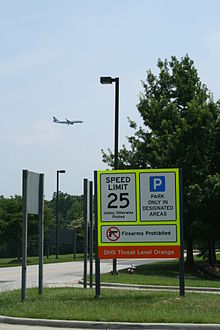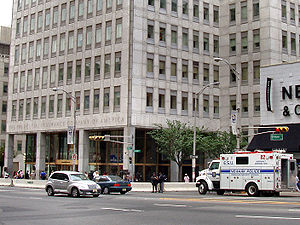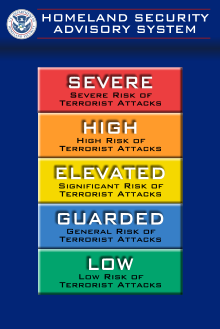- Homeland Security Advisory System
-
"HSAS" redirects here. For the rock band, see Hagar Schon Aaronson Shrieve. For the UK terror threat level system, see UK Threat Levels.
In the United States, the Homeland Security Advisory System was a color-coded terrorism threat advisory scale. The different levels trigger specific actions by federal agencies and state and local governments, and they affect the level of security at some airports and other public facilities. It is often called the "terror alert level" by the U.S. media. The system was, as scheduled, phased out April 27, 2011, and replaced with a new system called the National Terrorism Advisory System.[1] The phase-out was announced on January 27, 2011 by Secretary of Homeland Security Janet Napolitano during a speech at George Washington University.[2]
Contents
History
The system was created by Homeland Security Presidential Directive 3 on March 11, 2002, in response to the September 11 attacks. It was meant to provide a "comprehensive and effective means to disseminate information regarding the risk of terrorist acts to federal, state, and local authorities and to the American people." It was unveiled March 12, 2002, by Tom Ridge, then the Assistant to the President for Homeland Security. However, responsibility for developing, implementing and managing the system was given to the U.S. Attorney General.
In January 2003, the new Department of Homeland Security (DHS) began administering the system. The decision to publicly announce threat conditions is made by the Secretary of Homeland Security in consultation with the Assistant to the President for Homeland Security, according to Homeland Security Presidential Directive-5.[3]
On January 27, 2011, Secretary of Homeland Security Janet Napolitano announced that the Homeland Security Advisory System would be replaced by a new two-level National Terrorism Advisory System in April 2011. Napolitano, who made the announcement at George Washington University, said the color-coded system often presented "little practical information" to the public and that the new system will provide alerts "specific to the threat" and that "they will have a specified end date."[4][5][6]
Description
 Threat level Orange at Raleigh-Durham International Airport
Threat level Orange at Raleigh-Durham International Airport
Inspired by the success of the forest fire color system, the scale consists of five color-coded threat levels, which are intended to reflect the probability of a terrorist attack and its potential gravity.
- Severe (red): severe risk
- High (orange): high risk
- Elevated (yellow): significant risk
- Guarded (blue): general risk
- Low (green): low risk
The specific government actions triggered by different threat levels have not always been revealed to the public, although the government has provided general guidance for civilians[7] and federal agencies.[8] Actions have included increasing police and other security presence at landmarks and other high-profile targets, a closer monitoring of international borders and other points of entry, ensuring that emergency response personnel were ready, and, in some cases, deployment of members of the National Guard and State Guard to assist local law enforcement on security details.
Some of the actions taken as a result of the threat levels have been challenged as being illegal under the U.S. Constitution's Fourth Amendment. No court has yet ruled on these various actions.
The published terror alert notices have urged American citizens, especially those traveling in the transportation systems, to "be vigilant, take notice of their surroundings, and report suspicious items or activities to local authorities immediately."[9] In addition, DHS advises the public to prepare an emergency preparedness kit and a family emergency plan.[9]
This system is no longer in place. It was replaced in January 2011.
Criticism of the system
Objective criteria
There are no published criteria for the threat levels, and thus no independent way to tell whether the current threat level is accurate. The threat levels Green (low risk) and Blue (general risk) have never been used. The evidence cited to justify changes in threat levels has been stated vaguely (see below) and its sources have seldom been revealed. Supporters of the system defend this by stating that providing detailed, current intelligence about terror organizations would endanger the ability to gather similar information in the future.
Some critics[10] worry that the absence of clearly defined, objective criteria has allowed the baseline threat level to be established as elevated (yellow), thus precluding the system from ever dropping down to low (green) or general (blue). This limits the communicative value and options of the system to the three highest values. As persons become habituated to the threat level being perpetually elevated, they are increasingly likely to pay less attention to warnings issued.
Political manipulation
The lack of disclosure makes the system vulnerable to manipulation by government officials. These attributes have been criticized by cartoonists,[11] journalists,[12] entertainers,[13] independent writers,[14] and security experts.[15]
The alert level was raised once in 2004, an election year, leading some critics to speculate that the Bush Administration used them for political rather than strictly security reasons.[16][17] In 2009, Ridge alleged in his book The Test of Our Times: America Under Siege...and How We Can Be Safe Again that top aides to President Bush (including defense secretary Donald Rumsfeld and attorney general John Ashcroft) pressured him to raise the alert level on the eve of the November 2004 presidential election. Ridge refused. "After that episode, I knew I had to follow through with my plans to leave the federal government for the private sector," he said.[18]
In December 2004, the Homeland Security Advisory Council voted to review the color-coded system. One panel member suggested that it had outlived its usefulness.[19] In a public forum, Ridge conceded the system had invited "questions and even occasional derision."[20] Ridge also said that he had not always agreed when others pushed to raise the threat level. "Sometimes we disagreed with the intelligence assessment," Ridge said. "Sometimes we thought even if the intelligence was good, you don't necessarily put the country on [alert]. ... There were times when some people were really aggressive about raising it, and we said, 'For that?'"[21]
On its terror alert page, DHS makes clear that "Raising the threat condition has economic, physical, and psychological effects on the nation."[9] A study published in the January 2009 issue of the American Journal of Public Health found that the mentally ill, the disabled, African Americans, Latinos, Chinese Americans, Korean Americans, and non-U.S. citizens were likelier to think that the HSAS alert level was higher than it was, and to worry more and change their behavior due to those fears.[22]
Task force
A September 2009 report from the HSAS Task Force found that the "current system had functioned reasonably well" for institutional audiences, but that the "system's ability to communicate useful information in a credible manner to the public is poor", and that "there is a disturbing lack of confidence in the system." The task force recommended that future threats be more narrowly targeted by "specific region and sector under threat", rather than "elevating the alert status of the nation as a whole", and that the number of levels be reduced from five to three to acknowledge that "the new baseline for the United States is guarded." The task force was divided on whether to recommend abandonment of color-coding in the system, but asserted that if such a coding remains in use, "substantial reform is required."[23]
Threat level changes
 Homeland Security secured the Prudential Financial Building in Newark, New Jersey in August 2004 following the discovery of evidence of a terrorist threat to it.
Homeland Security secured the Prudential Financial Building in Newark, New Jersey in August 2004 following the discovery of evidence of a terrorist threat to it.
The HSAS threat level has changed 17 times as of September 2009[update].[23] In August 2004, DHS began identifying specific sectors under possible threat, including aviation, financial services, and mass transit.[23]
Severe (Red)
The threat level has been raised to Severe only once, which applied only to flights coming from the United Kingdom:
- August 10–14, 2006, in response to British law enforcement announcing it had disrupted a major terror plot to blow up an aircraft, DHS raised the threat level for commercial flights from the United Kingdom to the United States to Severe.[24]
High (Orange)
On a nationwide level, it has been raised to High five times:
- September 10–24, 2002, the first anniversary of the September 11, 2001 attacks.[25]
- February 7–27, 2003, near the end of the Muslim religious holiday Hajj. Intelligence reports suggested the possibility of terrorist attacks against "apartment buildings, hotels, and other soft or lightly secured targets."[25]
- March 17 – April 16, 2003, around the beginning of U.S. and Coalition military action in Iraq.[25]
- May 20–30, 2003, after the Riyadh compound bombings and the Casablanca bombings. According to Tom Ridge: "The U.S. Intelligence Community believes that Al Qaeda has entered an operational period worldwide, and this may include terrorist attacks in the United States."[25]
- December 21, 2003 – January 9, 2004, citing intelligence information suggesting large-scale attacks around the holiday season.[25]
In addition, the alert has been raised to High on a select or partial basis three times:
- August 1 – November 10, 2004, for specific financial institutions in northern New Jersey, New York, and Washington, D.C., citing intelligence pointing to the possibility of a car or truck bomb attack, naming specific buildings as possible targets.[26][27]
- July 7, 2005 – August 12, 2005, for mass transit systems only. The DHS secretary announced the level after the 7 July 2005 London bombings despite the absence of "specific, credible information suggesting imminent attack" in the United States.[28]
- August 10, 2006 – present, for all domestic airline flights and all international flights to or from the United States, with the exception of flights from the United Kingdom to the United States. Flights from the United Kingdom to the United States had been under a Severe alert, but were downgraded to High on August 13, 2006.[24]
For more details on this topic, see 2006 transatlantic aircraft plot.
Elevated (Yellow)
- March 12 – September 10, 2002
- September 25, 2002 – February 6, 2003
- February 28 – March 16, 2003
- April 17 – May 20, 2003
- May 31, 2003 – August 1, 2004
- November 10, 2004 – July 8, 2005
- August 12, 2005 – April 27, 2011 (Replaced by the National Terrorism Advisory System, but excludes domestic and international flights)
Low (Green) and Guarded (Blue)
The threat level was never lowered to Low (Green) or Guarded (Blue).[23] It was recommended in a September 2009 Task Force report to remove the Low and Guarded conditions from the Alert System altogether and set Yellow (Elevated) to "Guarded" as the new baseline of the system, without changing the baseline conditions issued when under Yellow in the current system.
Other terror warnings
Other official terrorism warnings issued without raising the threat level above Elevated:
- May 28, 2004, citing "credible evidence" of terrorist intent to affect upcoming elections.[citation needed]
- July 8, 2004, again citing "credible evidence" of terrorist intent to affect upcoming elections.[citation needed]
- July 11, 2007, reports that Al Qaeda has rebuilt operating capability, strength to level not seen before the September 11 attacks; strongest since summer of 2001.[29]
- July 12, 2007, reports that Al Qaeda is stepping up efforts to sneak terrorists into the United States and has rebuilt capability to strike there.[citation needed]
See also
- BIKINI state (United Kingdom)
- DEFCON
- MARSEC
- UK Threat Levels
- Vigipirate (France)
References
- ^ "Color-coded terror warnings to be gone by April 27". Yahoo! News. Associated Press. 2011-01-26. http://news.yahoo.com/s/ap/20110126/ap_on_re_us/us_color_coded_threats. Retrieved 26 January 2011.
- ^ Mathes, Michael (January 27, 2011). "New US terror alert system replaces color code". Google News (Agence France-Presse). http://www.google.com/hostednews/afp/article/ALeqM5j4jVmMvd0grzQ2cm5yMrHggs8EgQ?docId=CNG.b27ce982d5a2c46fdde0c964ca0fcea9.f51. Retrieved January 27, 2011.
- ^ Office of the Press Secretary (February 28, 2003). "Homeland Security Presidential Directive/HSPD-5". The White House. Archived from the original on 2006-05-16. http://web.archive.org/web/20060516013831/http://georgewbush-whitehouse.archives.gov/news/releases/2003/02/20030228-9.html. Retrieved 2006-05-16.
- ^ By the CNN Wire Staff (2001-09-11). "U.S. replaces color-coded terror alerts - CNN.com". Edition.cnn.com. http://edition.cnn.com/2011/TRAVEL/01/27/terror.threats/. Retrieved 2011-01-27.
- ^ Mathes, Michael. "AFP: New US terror alert system replaces color code". Google.com. http://www.google.com/hostednews/afp/article/ALeqM5j4jVmMvd0grzQ2cm5yMrHggs8EgQ?docId=CNG.b27ce982d5a2c46fdde0c964ca0fcea9.f51. Retrieved 2011-01-27.
- ^ (AP) – 1 day ago. "The Associated Press: Color-coded terror warnings to be gone by April 27". Google.com. http://www.google.com/hostednews/ap/article/ALeqM5jk6RbnF_Ef3qlgQiikIpBv0_0a5Q?docId=e070fdf0a6404339bb708d2a5a30cd0b. Retrieved 2011-01-27.
- ^ "Citizen Guidance on the Homeland Security Advisory System" (PDF). Department of Homeland Security. http://www.dhs.gov/xlibrary/assets/CitizenGuidanceHSAS2.pdf. Retrieved 2008-04-23.
- ^ "Homeland Security Advisory System--Guidance for Federal Departments and Agencies". Department of Homeland Security. http://www.dhs.gov/xinfoshare/programs/gc_1156876241477.shtm. Retrieved 2008-04-23.
- ^ a b c "Homeland Security Advisory System". September 27, 2007. http://www.dhs.gov/xinfoshare/programs/Copy_of_press_release_0046.shtm. Retrieved 2007-09-27.
- ^ "Homeland Security Advisory Council HSAS Task Force Stakeholder Feedback". 2009. http://www.dhs.gov/xlibrary/assets/hsas_task_force_stakeholder_feedback.pdf. Retrieved 2010-01-03.
- ^ Kirkeby, Cynthia; Sarah Lane (Jul 13, 2004). "Pinning the Tail on Terror". Classbrain.com. http://www.classbrain.com/artteensb/publish/article_338.shtml. Retrieved 2006-05-16.
- ^ Miller, Sara B. (August 4 2004). "Terror-alert system: how it's working". The Christian Science Monitor. http://www.csmonitor.com/2004/0804/p01s02-usgn.html.
- ^ J., Frank (May 22, 2003). "A Frank Guide to Homeland Security Alert Levels". http://www.imao.us/archives/000651.html. Retrieved 2006-05-16.
- ^ Wade, Anthony. "Election Season Terror Alert Chart". http://www.opednews.com/wade_071904_warning.htm. Retrieved 2006-05-16.
- ^ Schneier, Bruce (October 2004). "Do Terror Alerts Work?". http://www.rakemag.com/stories/section_detail.aspx?itemID=4851&catID=146&SelectCatID=146. Retrieved 2006-05-16.
- ^ Kamen, Al (October 13 2004). "Will Terror Alert Level Show Its True Colors?". Washington Post: A19. http://www.washingtonpost.com/wp-dyn/articles/A28037-2004Oct12.html. Retrieved 2006-05-16.
- ^ "Dems Question Timing of Terror Alert". FOX News. August 4, 2004. Archived from the original on May 10, 2006. http://web.archive.org/web/20060510003203/http://www.foxnews.com/story/0,2933,127998,00.html. Retrieved 2006-05-16.
- ^ Knox, Olivier (2009-08-20). "Former Bush aide cites politics in 'terror alert'". Google.com. http://www.google.com/hostednews/afp/article/ALeqM5h1W_dkUJZmLCnpf-AJQwNa0N-ptg. Retrieved 2011-01-27.
- ^ Sifuentes, Edward (December 15, 2004). "Ridge comes to San Diego and defends color-coded warning system". http://www.nctimes.com/articles/2004/12/15/news/top_stories/19_42_4412_14_04.txt. Retrieved 2006-05-16.
- ^ "404 error". Archived from the original on May 14, 2006. http://web.archive.org/web/20060514052734/http://www.freep.com/news/nw/ridge15e_20041215.htm. Retrieved 2006-05-16.
- ^ "404 error". http://wireservice.wired.com/wired/story.asp?section=Breaking&storyId=1031895&tw=wn_wire_story. Retrieved 2006-05-16.[dead link]
- ^ Disabled and Other Vulnerable Groups More Susceptible to Terrorism Fears Newswise, Retrieved on January 21, 2008.
- ^ a b c d "Homeland Security Advisory System Task Force Report and Recommendations" (PDF). http://www.dhs.gov/xlibrary/assets/hsac_final_report_09_15_09.pdf. Retrieved 2011-01-27.
- ^ a b Jordan, Lara (August 10, 2006). "U.S. raises airline threat level to highest level, first time ever, in response to British threat". San Diego Union-Tribune. http://www.signonsandiego.com/news/nation/terror/20060810-0818-us-terrorplot.html. Retrieved 2006-08-10.
- ^ a b c d e "Chronology of Changes to the Homeland Security Advisory System". Dhs.gov. http://www.dhs.gov/xabout/history/editorial_0844.shtm. Retrieved 2011-01-27.
- ^ "Gov't Warns of Threats Against Buildings (archived version)". Archived from the original on 2004-08-04. http://web.archive.org/web/20040804020410/http://abcnews.go.com/wire/US/ap20040801_723.html. Retrieved 2006-11-21.
- ^ "Homeland Security Advisory System". Department of Homeland Security. http://www.dhs.gov/dhspublic/display?theme=29. Retrieved 2006-05-16.
- ^ Stout, David (July 7, 2005). "U.S. Raises Threat Level for Mass Transit". New York Times. http://www.nytimes.com/2005/07/07/national/07cnd-security.html?ex=1278388800&en=fbba97fa72e31afd&ei=5090&partner=rssuserland. Retrieved 2006-05-16.
- ^ "Government report: Al Qaeda strongest since September 11, 2001". CNN. July 12, 2007. http://www.cnn.com/2007/US/07/11/al.qaeda.report/index.html. Retrieved 2007-07-11.
External links
- Homeland Security Advisory System - Explanation and current threat level
- White House press release: Gov. Ridge Announces Homeland Security Advisory System
- White House press release: Homeland Security Presidential Directive-3
- New Report on Homeland Security Threat Advisory System Highlights Need for Reform
Categories:- Alert measurement systems
- United States Department of Homeland Security
- Disaster preparedness in the United States
- Color codes
- 2002 introductions
Wikimedia Foundation. 2010.

